the orange show center for visionary art's
eyeopener tours:
Southern Louisiana, 2006


"Boogie Back to the Bayou"
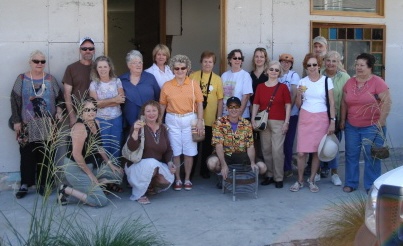
This year's out-of-town Eyeopener Tour took place in October, having skipped our traditional Memorial Day scheduling, but the 16 month wait was well worth it:
four days, 21 participants, world-class visionary art, perfect weather, two nights in the French Quarter, a ton of bread pudding, a stuck door on a high curb,
and the good people of the Great State of Louisiana.
Get on the bus, here we go:
Following a Friday morning bus ride across the border into Louisiana, our first stop was in Breaux Bridge for lunch at a legendary Cajun eatery, Mulate's Restaurant.
The ceiling is decorated with years of business cards and the entrance vestibule is lined with the names of celebrity diners, from Bob Dylan to Robert Duvall to Mickey Mantle.
Yep, the food was good 'n' fried. (The first of many outstanding on-the-mark restaurant choices by Eyeopener Tour committee member Pat Holleman.)

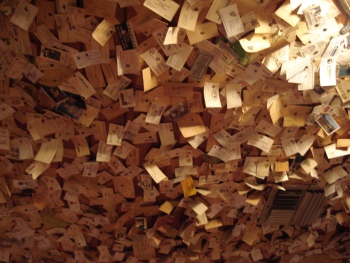

The ceiling of Mulate's Restaurant, Breaux Bridge

Our first tour visit was in the eastern suburbs of Baton Rouge to see one of the best works of American
architecture of the new century, St. Jean Vianney Catholic Church. In an age when so-called "star architects" are cranking out cheap-thrill gymnastics,
Trahan Architects of Baton Rouge have created a work both timeless and sublime. St. Jean presents an almost inconspicuous exterior of smooth, gray concrete, but
closer inspection reveals a pair of 14-foot high sculpted bronze entry doors, encrusted with object ranging from wedding rings to eyeglasses to a baby's footprints.
(The doors are by artist Max DeMoss, who also created the church’s stunning interior statuary.) Upon entering the octagon-shaped interior,
one is enveloped by a wash of natural light - an effect that recalls the work of architects Louis Kahn and Tadao Ando.
In the three corner chapels, dramatic beams of sunlight accent the religious artwork.

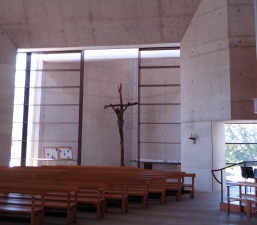
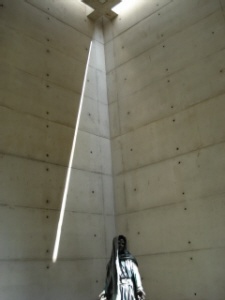
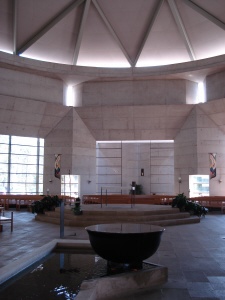
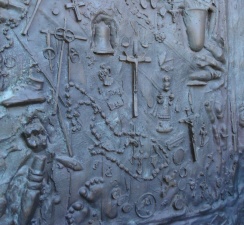

St. Jean Vianney Catholic Church, Baton Rouge

Just a few blocks south of the state capitol building sits the newly opened Louisiana State Museum - Baton Rouge.
Within the steel and glass modern exterior are hundreds of artifacts of Louisiana history and culture,
including a 48-foot shrimp trawler, Louis Armstong's trumpet, decorated Mardi Gras lawnmowers
from the Krewe of Yazoo, Napoleon's death mask, plus a 1930's painting depicting Huey Long's assassination, straight out of "CSI".

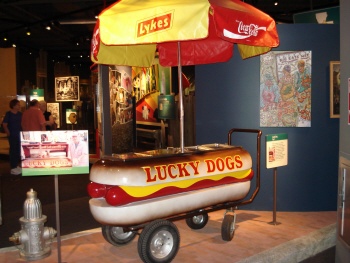
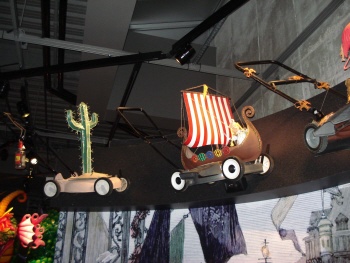

The Louisiana State Museum, Baton Rouge

Our last stop for the afternoon was a visit with an artist who creates not in marble or granite nor bronze or silver, but in
the simple wooden toothpick. Michael Anthony Smith, a Louisiana native, began making sculptures
using toothpicks as a teenager in high school. With subject matter ranging from birds and butterflies to briefcases and saxophones,
Smith's art has been exhibited in numerous galleries and museums, and he has shared his story and talent in school art workshops around the state.
In 2005 Michael received his greatest honor as an inductee into the Guinness Book of World Records
for his 320 lb, 15 foot, three-million-toothpick sculpture of an alligator named Tag. Also welcoming our group was Ms. Sadie Roberts-Joseph, founder of the Museum of African-American History of Baton Rouge.

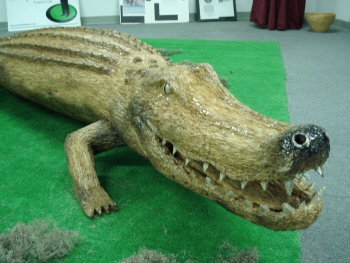
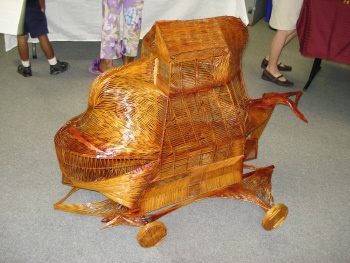
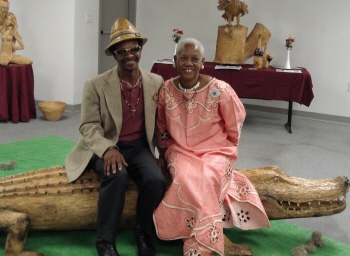
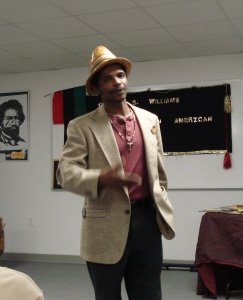

Michael A. Smith ("The Louisiana Toothpick Man")

Our evening accommodations in lively downtown Baton Rouge were in the newly restored Hilton Capitol Center Hotel, known in its heyday as The Heidelberg.
Constructed in 1927, the hotel became famous during the administration of Gov. Huey Long.
Rarely spending time in the Governor's Mansion, Long would hold court in Room 1021, scheduling
4:00 am meetings with political cronies, and using a secret tunnel to reach his mistress
across the street in the King Hotel.

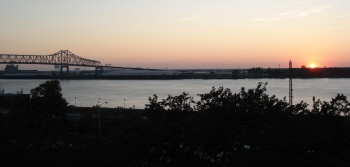
 sunset over the Mississippi
sunset over the Mississippi

Saturday morning began with a slight hitch as our bus driver learned about the problems that can result from the
high sidewalk curbs of downtown Baton Rouge. (The problem being a stuck bus door that was unstuck while the group was touring the state capitol building.)
The tallest state capitol building in the U.S. is approached from a grand staircase of 48 steps, representing each of the then 48 states. On the
interior, the two-story Memorial Hall is an amazing display of material and detail, including walls of Vermont and Italian marbles, a bronze
relief map of Louisiana, rich murals, and priceless vases of porcelain and solid gold.
During our tour of the capitol we also learned much about the man responsible for its creation, the legendary / notorious Huey P. Long. The fact
that this eloaborate Art Deco structure was built in only 14 months stands as a testament to the power that "The Kingfish" held over the state. Bullet
holes are still visible in the corridor where Long was assassinated in 1935, and his statue-grave sits in the center of the front gardens.
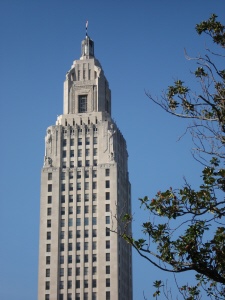
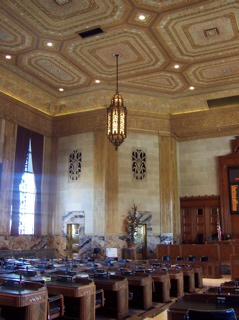 photo courtesy Jill Whitten and Rob Proctor
photo courtesy Jill Whitten and Rob Proctor
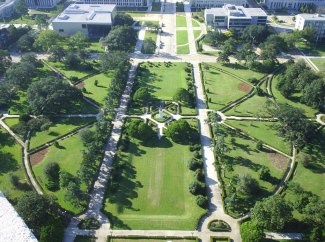 photo courtesy Nancy Lauritsen
photo courtesy Nancy Lauritsen

The Louisiana State Capitol Building, Baton Rouge
(and view from the observation deck)

We then said goodbye to Baton Rouge and headed south along the Mississippi River towards the Delta. After another Cajun lunch in Houma, we continued south another 17 miles to the bayouside community of Chauvin. It was here in the 1990's
where a reclusive bricklayer named Kenny Hill created one of the most powerful and enigmatic folk art sites in America, now known as the
Chauvin Sculpture Garden. Hill settled here in 1988, using a tent as his shelter on a small plot
of property along Bayou Petit Caillou. Shortly after he built a simple home for himself, and in 1990 he suddenly started to assemble bricks and concrete into a fantastic environment of colorful sculptures.
Religious in nature, the sculptural figures express struggle and pain along with deep spirituality. Hill included himself in many of the compositions,
with bleeding heart, guided and lifted by angels. The central work in the garden is a 45-foot lighthouse, covered with clinging figures including ships, soldiers,
cowboys, angels, and a Christ-like self-portrait. Without explanation, Hill left Chauvin and his incredible creation in early 2000, and is now reportedly living in Arkansas.
Before he left town, a Nicholls State University art professor asked him asked, "Is this your vision?" Hill replied, "It's about living and life and everything I've learned."
Our guides for the tour were Kathy Chauvin and Jenny Authement of the Nicholls State University Art Studio. (The studio is just across the road from the garden and houses a small museum devoted to
Hill and exhibits work by regional artists.)
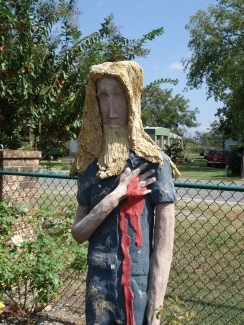
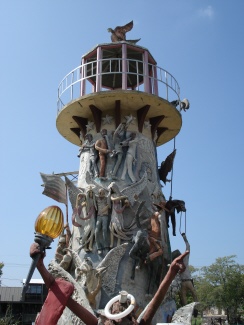
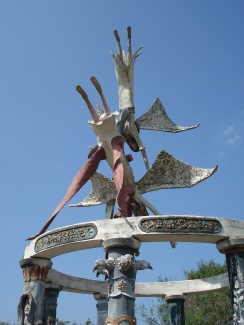
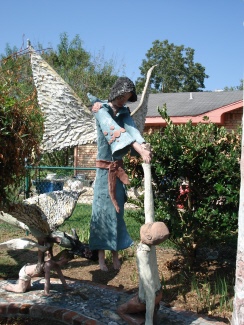
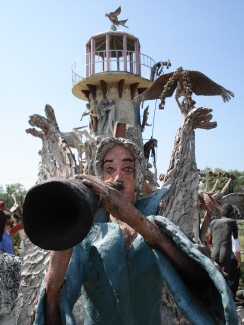
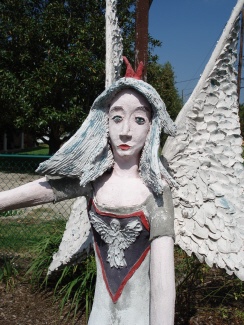
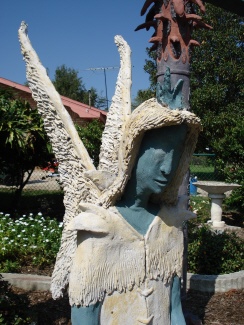
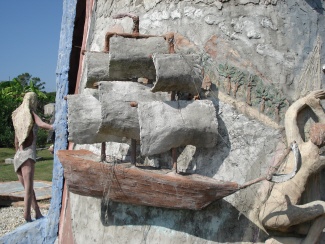
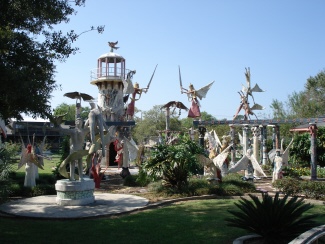
Kenny Hill's Chauvin Sculpture Garden

From Chauvin it was northeast to New Orleans, to help celebrate the rebirth and rebuilding of the Crescent City. Our first stop was on the
west bank of the Mississippi, in the Algiers District, to visit an old friend of the Orange Show, artist Charles Gillam and his Folk Art Zone.
Gillam has used his love of woodcarving and painting to transform blighted properties into a refuge of revitalization.
Gillam, who was born near Alexandria, grew up in the Lower Ninth Ward. As a teenager, he became fascinated with the artists of the French Quarter
and asked them for discarded brushes and leftover paint. One of his first mentors was painter Willie White, considered one of the legendary folk artists of New Orleans.
Several years later Charles found inspiration in the driftwood and cypress branches that he picked up along the levee banks of the Mississippi. From the found wood he began carving totems and figures, many dedicated to the giants of blues,
jazz, and soul music. In 2000, the chance visit of artist Dr. Charles Smith, who was revisiting his hometown of New Orleans, led to a collaboration that became The Folk Art Zone. Charles and his family guided us through the two main components of the project,
the Blues Museum as well as the exterior sculpture garden (including a moving tribute to the victims of the World Trade Center attacks).
We are certain that over the next few years there will be even more incredible additions to The Zone, and we can't wait to get back.
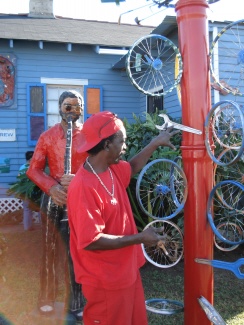
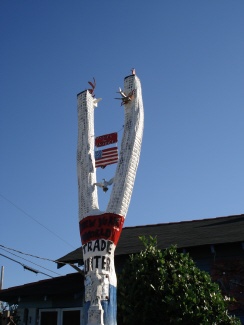
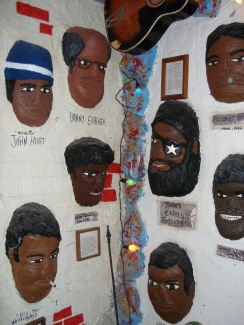
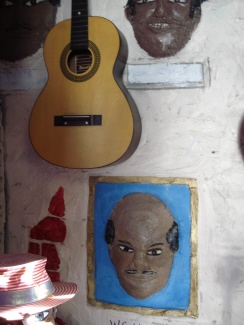
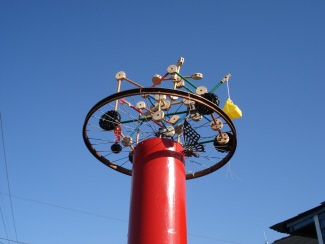
Charles Gillam's Folk Art Zone
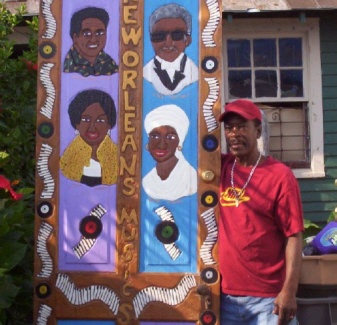 artist Charles Gillam
artist Charles Gillam
photo courtesy Charles Gillam

From Algiers it was over the Mississippi River bridge to the French Quarter and check-in at our home for the next two evenings, the Hotel St. Marie,
located just a block away from Bourbon Street.
We were welcomed at the beautiful courtyard hotel by manager Steve Valentino,
who introduced us to The Quarter over a champagne toast.
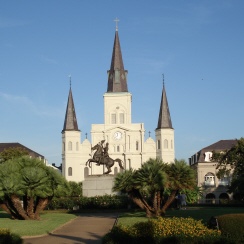
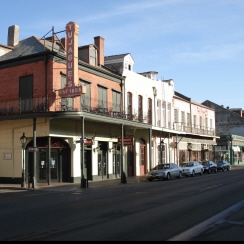
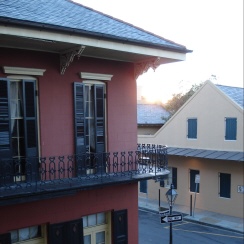
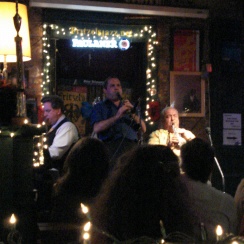
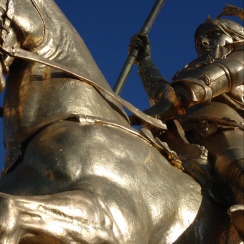
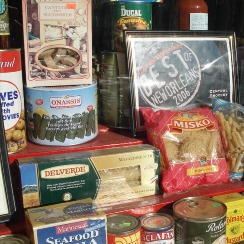
In The French Quarter

Our Sunday touring began in peace and rest at St. Roch Cemetery and Shrine in the Faubourg Marigny District, just downriver from the French Quarter.
The cemetery and shrine were begun in 1874, built on the promise of a German priest. In 1868 New Orleans had been afflicted with a yellow fever epidemic,
leading Father Peter Leonard Thevis to direct the congregation of Holy Trinity Catholic Church
to pray to St. Roch to relieve the pestilence. Father Thevis also vowed that he would build a
chapel to the saint with his own hands. According to legend, not a single parishioner died of
the fever, and the Father kept his promise. At times, the chapel walls are lined with dozens of
artificial limbs, braces, and crutches as testament to the cures attributed to St. Roch.
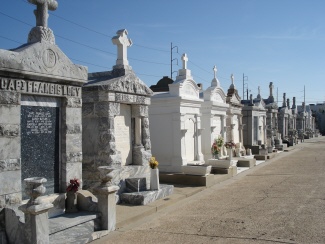
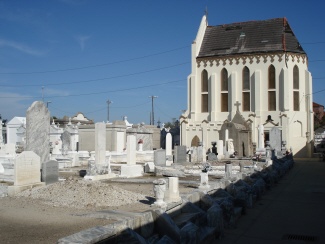
St. Roch Cemetery and Shrine

Our next visit was just a few blocks from St. Roch's at the home and gallery of architect Kirsha Kaechele, who has been active not only in the rebuilding and renovation of homes in the neighborhood,
but also in the overall future urban planning of the city. In addition to our group, Kirsha also welcomed friends and neighbors with a wonderful morning brunch, complete with wine, salmon, cheese, and cake.
Featured in the gallery space of the reconverted bakery building was the art of a surprise guest; acclaimed sculptor Clifton G. Webb. Webb, who has long been an activist and educator in the New Orleans arts community, has
several sculptures in the permanent collection of the New Orleans Museum of Art and the Ogden Museum of Southern Art.
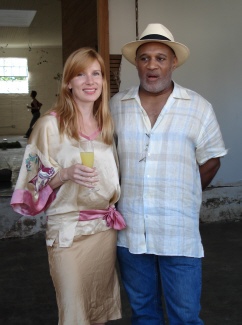
architect Kirsha Kaechele and artist Clifton G. Webb
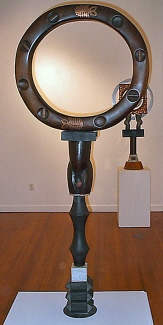
sculpture by Clifton G. Webb
photo courtesy of the artist

Across the Mississippi we drove from the Eastbank to the Westbank to act like tourists at
Mardi Gras World at Kern Studios, the largest float designing and building facility on earth.
Walking into the 75,000 square foot warehouse feels like entering a combination giant toy box, surrealistic painting, and 3-D horror movie.
It is here where nearly 75% of the floats that parade through the streets of New Orleans during Carnival season are created. The founder of
this empire of fiberglass and papier-mache is Blain Kern, a multi-generation Algerine.
The son of a Depression-era sign painter and part-time float builder, Kern established his float making company in 1947 and his
creations soon began to receive the attention from prominent Mardi Gras parade krewes. With inspiration from Walt Disney, Kern's floats
were known as the most colorful and outlandish, leading to a growth of client base well beyond New Orleans. In 1984,
with an ever-present healthy dose of self-promotion, Kern opened Mardi Gras World to the public. During the guided tour we tried on costumes, witnessed the construction of new floats, saw
classic old floats, learned a bit about Mardi Gras history, and also received a gumbo cooking demonstration while enjoying lunch among the giant heads and creatures of Fat Tuesday.
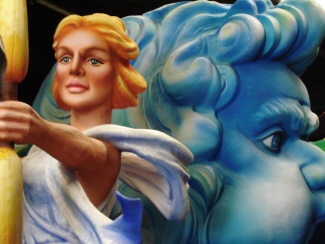
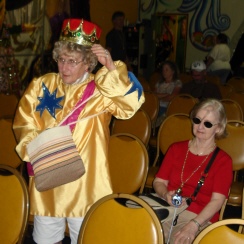
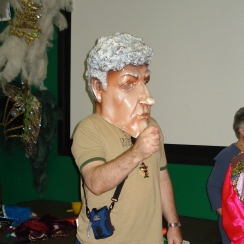
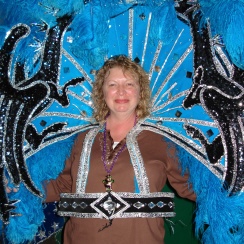
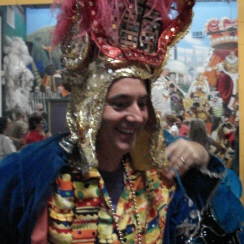
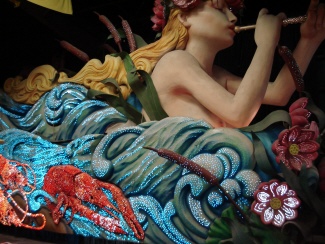
Mardi Gras World, New Orleans
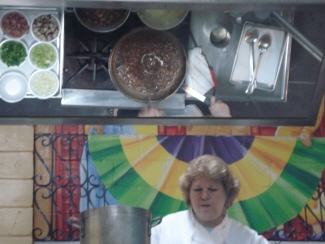
gumbo cooking demonstration at Mardi Gras World
Once again we bridged it back over to Eastbank (or is it to Westbank??) to the Warehouse District for a short stop at the Ogden Museum of Southern Art.
When we arrived there was a symposium being held in the lobby, so we had to quietly make our way through the crowd - not an easy task for our rowdy bunch.
Up on the gallery levels, we made our way through some of the classics of southern art, including work by Walter Anderson, George Ohr, and William Christenberry.
We were also lucky enough to see a newly-opened exhibition of drawings by Minnie Evans, one of the giants of American folk art.
Speaking of the giants of American folk art, our next destination was a home that was filled with giants and legends.
Located on St. Charles Avenue in the lush, subtropical Garden District is the home to one of the finest collections of self-taught art not only in New Orleans,
but also in America. Art collectors for all of their lives, Alvina and Paul Haverkamp began to
focus on folk art around 1979. Their walls are filled with the legends of Southern self-taught art; Butler, Doyle, Finster, Harvey, Morgan, Sudduth, Traylor, Young, and many more.
Works from their collection have been included in numerous landmark exhibitions, including the 2004 Sister Gertrude Morgan retrospective and
the 1994 "Passionate Visions of the American South" show. Unfortunately, this was one of the last occasions for Alvina and Paul to share
their collection with visitors; they are planning on moving to Mexico next year and will be selling most of their artwork.
As Alvina writes, "The collection is especially poignant to me now, after Katrina, because it documents a way of life so rich, much of which is gone forever."
(And if you're interested in work from their collection, please visit www.haverkampfolkart.com).
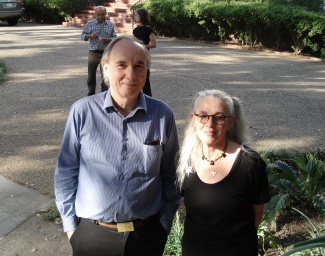
Paul and Alvina Haverkamp

After returning back to our hotel, we trudged our way through The Quarter for a last-evening group dinner of Creole cuisine at Muriel's Jackson Square Restaurant. (Another winning recommendation from Ms. Holleman.)
Following dinner, some scattered throughout The Quarter, while others trudged back to the hotel, their bellies filled with wood grilled BBQ shrimp, pecan crusted puppy drum, double cut pork chops,
and free range chicken breasts with fried polenta, haricots verts, and a green peppercorn and chardonnay sauce. Only one of the group was temporarily unaccounted for, having ducked inside a souvenir shop.
On Monday morning we departed The Big Easy and made our way north across Lake Pontchartrain Causeway, the world's longest overwater highway bridge. Following the only wrong turn of the trip, we headed to the one and only UCM Museum in Abita Springs.
It is pronounced "You See 'Em", and in the opinion of the director of the New Orleans Museum of Art it's "the most intriguing and provocative museum in Louisiana." Artist John Preble calls his hand-made roadside attraction "Louisiana's Most Eccentric Museum."
This combination Smithsonian Institute / folk art environment includes both hand built inventions and thrift store collections. From paint-by-number art to postcards, radios to combs, animated dioramas to a house of tiles, Buford the bassigator to Darrell the dogigator,
an Airstream trailer to an alien saucer, we saw 'em at the UCM.
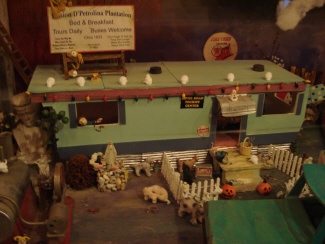
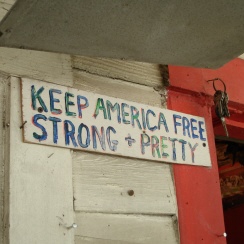
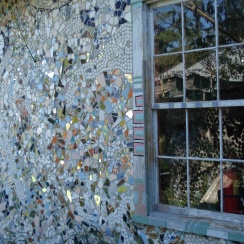
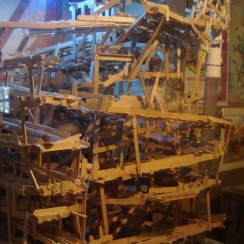
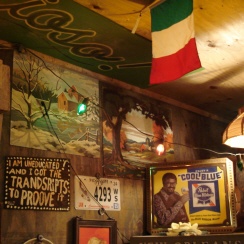
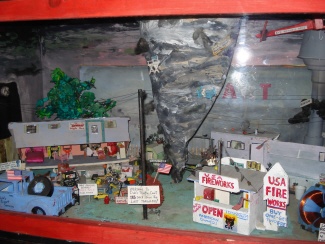
The UCM Museum, Abita Springs
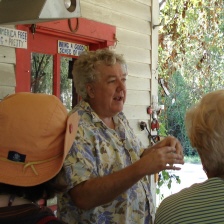
Artist John Preble of the UCM Museum

Of course we had one last incredible meal, this time at the Abita Quail Farm in Abita Springs. (No quail, but the best bread pudding on the tour.)
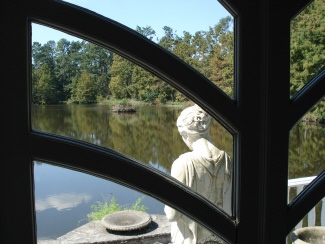
Abita Quail Farm
Back in 2001, on the Eyeopener Tour of Chicago and Wisconsin, we had the honor of visiting Dr. Charles Smith and his legendary sculpture
environment in Aurora, Illinois. For our very last stop on this 2006 tour we had the privilege of experiencing a sneak preview of his latest visionary projects.
The Illinois site, The African-American Heritage Museum (Aurora), was an amazing and
inspiring monument to the contributions and experiences of Black America.
The property of his former home was filled with sculpted tributes to African-American heroes and martyrs, including Harriett Tubman, Frederick Douglass,
Emmett Till, and Dr. Martin Luther King, Jr. In 2002, Dr. Smith moved from Illinois back to his home state of Louisiana, where he began collaborating with
Charles Gillam on The Folk Art Zone. On this sunny afternoon in Hammond, we were met with Louisiana hospitality from not only our old friend Dr. Smith, but also several
area activists who have been working to bring cultural tourism to the region, including Lue Russell of the Greater Hammond Community Resource and Development Center,
George Perkins, president of the Tangipahoa African-American Heritage Museum, Ms. Eddie Monroe, an associate of Dr. Smith, as well as Louisiana State Representative Henry "Tank" Powell.
(The first politician ever to greet an Eyeopener Tour!)
Our first of three stops in Hammond was to the Tangipahoa African-American Heritage Museum, a soon-to-open cultural center where Dr. Smith is contributing his knowledge and energy. The center is being renovated from a former school building and will open next February.
From there we continued to the second project in town, The Charles Smith Folk Art Emporium, an existing house that will be converted to a studio workshop for local and visiting artists. Exterior sculptures will include tributes to
prominent African-Americans of Louisiana and U.S. history, as well as a memorial to the victims of Hurricane Katrina. It was only a short drive from the studio to Dr. Smith's own home, where he and his wife offered refreshments
along with a look at dozens of new sculptures that will populate the new projects. As a final surprise, our tour leader was presented with a wonderful gift from the group and Dr. Smith - a statue of renowned
photographer, film director, writer, composer, (and one of our tour leader's heroes), Gordon Parks.
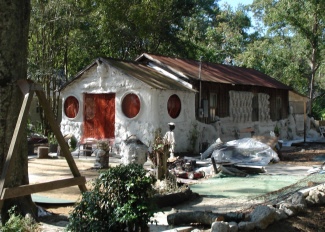
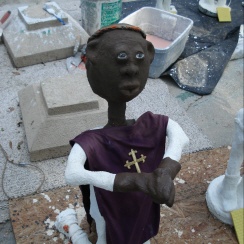
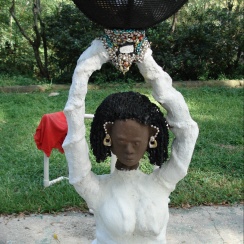
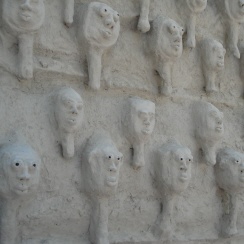
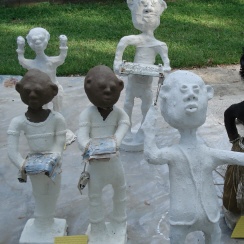
the art of Dr. Charles Smith, Hammond
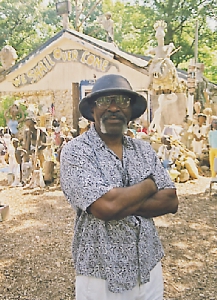
Dr. Charles Smith
(at his Illinois home in 2000)
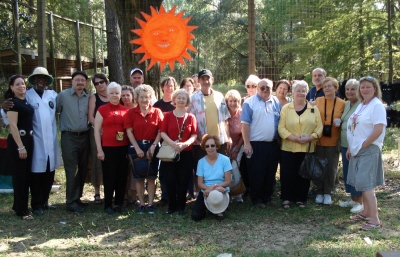
As we've said before on past tour reports, that's all folks. A Texas (and Louisiana) sized thank you to all of our new and old friends that we visited and helped us in Baton Rouge, Chauvin, New Orleans, Abita Springs, and Hammond, and last but not least
all of our exhausted yet well-fed tour participants.
Please visit us soon in Houston, or join us next year on the road to the Carolinas in May and Austin in October !
unless noted otherwise, photos by Larry Harris
back to more roadtrips
back to the home of NarrowLarry




![]()







![]()























































